
Love dart
Encyclopedia
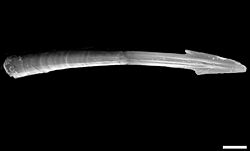

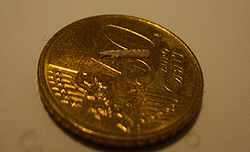
Calcium carbonate
Calcium carbonate is a chemical compound with the formula CaCO3. It is a common substance found in rocks in all parts of the world, and is the main component of shells of marine organisms, snails, coal balls, pearls, and eggshells. Calcium carbonate is the active ingredient in agricultural lime,...
or chitin
Chitin
Chitin n is a long-chain polymer of a N-acetylglucosamine, a derivative of glucose, and is found in many places throughout the natural world...
ous dart
Dart (missile)
Darts are missile weapons, designed to fly such that a sharp, often weighted point will strike first. They can be distinguished from javelins by fletching and a shaft that is shorter and/or more flexible, and from arrows by the fact that they are not of the right length to use with a normal...
which some hermaphroditic land snail
Snail
Snail is a common name applied to most of the members of the molluscan class Gastropoda that have coiled shells in the adult stage. When the word is used in its most general sense, it includes sea snails, land snails and freshwater snails. The word snail without any qualifier is however more often...
s and slug
Slug
Slug is a common name that is normally applied to any gastropod mollusc that lacks a shell, has a very reduced shell, or has a small internal shell...
s create. Love darts are made in sexually mature animals only, and are used as part of the sequence of events during courtship
Courtship
Courtship is the period in a couple's relationship which precedes their engagement and marriage, or establishment of an agreed relationship of a more enduring kind. In courtship, a couple get to know each other and decide if there will be an engagement or other such agreement...
, before actual mating
Mating
In biology, mating is the pairing of opposite-sex or hermaphroditic organisms for copulation. In social animals, it also includes the raising of their offspring. Copulation is the union of the sex organs of two sexually reproducing animals for insemination and subsequent internal fertilization...
takes place. Darts are quite large compared to the size of the animal: in the case of the semi-slug
Semi-slug
Semi-slugs, also spelled semislugs, are land gastropods whose shells are too small for them to retract into, but the shell is not quite vestigial...
genus Parmarion
Parmarion
Parmarion is a genus of air-breathing land semi-slugs, terrestrial pulmonate gastropod mollusks in the family Ariophantidae. Parmarion is the type genus of the Parmarioninae, that is a synonym of Ostracolethinae....
, the length of a dart can be up to one fifth that of the semi-slug's foot.
Prior to copulation, each of the two snails (or slugs) attempt to "shoot" one (or more) darts into the other snail (or slug). There is no organ to receive the dart; this action is more analogous to a stabbing
Stabbing
A stabbing is penetration with a sharp or pointed object at close range. Stab connotes purposeful action, as by an assassin or murderer, but it is also possible to accidentally stab oneself or others.Stabbing differs from slashing or cutting in that the motion of the object used in a stabbing...
, or to being shot with an arrow
Arrow
An arrow is a shafted projectile that is shot with a bow. It predates recorded history and is common to most cultures.An arrow usually consists of a shaft with an arrowhead attached to the front end, with fletchings and a nock at the other.- History:...
. The dart does not fly through the air to reach its target however; instead it is fired as a contact shot
Contact shot
A contact shot is defined as a gunshot wound incurred while the muzzle of the firearm is in direct contact with the body at the moment of discharge. Contact shots are often the result of close range gunfight, suicide or execution...
.
The love dart is emphatically not a penial stylet
Stylet
A stylet is a hard, sharp, anatomical structure found in some invertebrates.For example, the word stylet or stomatostyle, is used for the primitive piercing mouthparts of some nematodes and some nemerteans...
(in other words this is not an accessory organ for sperm transfer). The exchange of sperm
Sperm
The term sperm is derived from the Greek word sperma and refers to the male reproductive cells. In the types of sexual reproduction known as anisogamy and oogamy, there is a marked difference in the size of the gametes with the smaller one being termed the "male" or sperm cell...
between both of the two land snails is a completely separate part of the mating progression. Nevertheless, recent research shows that use of the dart can strongly favor the reproductive outcome for the snail that is able to lodge a dart first in its partner. This is because mucus on the dart introduces a hormone
Hormone
A hormone is a chemical released by a cell or a gland in one part of the body that sends out messages that affect cells in other parts of the organism. Only a small amount of hormone is required to alter cell metabolism. In essence, it is a chemical messenger that transports a signal from one...
-like substance that allows far more of its sperm to survive.
Love darts, also known as shooting darts, or just as darts, are shaped in many distinctive ways which vary considerably between species. What all the shapes of love darts have in common is their harpoon-like
Harpoon
A harpoon is a long spear-like instrument used in fishing to catch fish or large marine mammals such as whales. It accomplishes this task by impaling the target animal, allowing the fishermen to use a rope or chain attached to the butt of the projectile to catch the animal...
or needle-like
Sewing needle
A sewing needle is a long slender tool with a pointed tip. The first needles were made of bone or wood; modern ones are manufactured from high carbon steel wire, nickel- or 18K gold plated for corrosion resistance. The highest quality embroidery needles are plated with two-thirds platinum and...
ability to pierce.

The mating dance
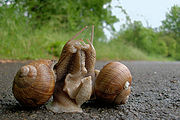

Mating
In biology, mating is the pairing of opposite-sex or hermaphroditic organisms for copulation. In social animals, it also includes the raising of their offspring. Copulation is the union of the sex organs of two sexually reproducing animals for insemination and subsequent internal fertilization...
begins with a courting ritual. For example, in land snails of the genus Helix
Helix (genus)
Helix is a genus of large air-breathing land snails, terrestrial pulmonate gastropod molluscs. This genus is native to Europe and the regions around the Mediterranean Sea. Helix is the type genus of the family Helicidae....
, including the escargot Helix pomatia
Helix pomatia
Helix pomatia, common names the Burgundy snail, Roman snail, edible snail or escargot, is a species of large, edible, air-breathing land snail, a terrestrial pulmonate gastropod mollusk in the family Helicidae...
, and the common garden snail Helix aspersa
Helix aspersa
Helix aspersa, known by the common name garden snail, is a species of land snail, a pulmonate gastropod that is one of the best-known of all terrestrial molluscs. The species has been placed in the genus Helix, in all sources between 1774 and 1988 and in most sources until recently...
(also known as Cornu aspersa and Cantareus aspersus), copulation is preceded by an elaborate tactile courtship.
The two snails circle around each other for up to six hours, touching with their tentacles, and biting lips and the area of the genital pore, which shows some preliminary signs of the eversion of the penis. As the snails approach mating, hydraulic pressure builds up in the blood sinus surrounding the organ housing the dart. Each snail manoeuvres to get its genital pore in the best position, close to the other snail's body. Then, when the body of one snail touches the other snail's genital pore, it triggers the firing of the dart.
The darting can sometimes be so forceful that the dart ends up buried in the internal organs. It can also happen that a dart will pierce the body or head entirely, and protrude on the other side.
After both snails have fired their darts, the snails copulate and exchange sperm.
A snail does not have a dart to fire the very first time it mates, because the first mating is necessary to trigger the process of dart formation. Once a snail has mated, it fires a dart before some, but not all, subsequent matings. A snail often mates without having a dart to use, because it takes time to create a replacement dart. In the case of the garden snail Helix aspersa, it takes a week for a new dart to form.
The dart is shot with some variation in force, and with considerable inaccuracy, such that one-third of the darts that are fired in Helix aspersa either fail to penetrate the skin, or miss the target altogether. Snails have only very simple visual systems and cannot see well enough to use vision to help aim the darts.
Function
Although the existence and use of love darts in snails has been known for at least several centuries, until recently the actual function of love darts was not properly understood.It was long assumed that the darts had some sort of "stimulating" function, and served to make copulation more likely. It was also suggested that darts might be a "gift" of calcium. These theories have proved not to be accurate; recent research has led to a better understanding of the strange phenomenon of love darts.
The two species that have been studied the most are Helix aspersa
Helix aspersa
Helix aspersa, known by the common name garden snail, is a species of land snail, a pulmonate gastropod that is one of the best-known of all terrestrial molluscs. The species has been placed in the genus Helix, in all sources between 1774 and 1988 and in most sources until recently...
, the garden snail, and Helix pomatia
Helix pomatia
Helix pomatia, common names the Burgundy snail, Roman snail, edible snail or escargot, is a species of large, edible, air-breathing land snail, a terrestrial pulmonate gastropod mollusk in the family Helicidae...
, the edible escargot. In Helix aspersa
Helix aspersa
Helix aspersa, known by the common name garden snail, is a species of land snail, a pulmonate gastropod that is one of the best-known of all terrestrial molluscs. The species has been placed in the genus Helix, in all sources between 1774 and 1988 and in most sources until recently...
(aka Cantareus aspersus), the dart is coated with a special mucus which contains a hormone-like substance. This substance contracts one part of the female half of the reproductive system of the snail that is struck with the dart, and this allows many more sperm to survive, significantly increasing the likelihood of a successful fertilization.
Morphology of darts
The love dart, also known as a "gypsobelum", is often made of calcium carbonateCalcium carbonate
Calcium carbonate is a chemical compound with the formula CaCO3. It is a common substance found in rocks in all parts of the world, and is the main component of shells of marine organisms, snails, coal balls, pearls, and eggshells. Calcium carbonate is the active ingredient in agricultural lime,...
which is secreted by a specialized organ within the reproductive system of several families of air-breathing snails and slugs, mainly in terrestrial pulmonate gastropod mollusks within the clade
Clade
A clade is a group consisting of a species and all its descendants. In the terms of biological systematics, a clade is a single "branch" on the "tree of life". The idea that such a "natural group" of organisms should be grouped together and given a taxonomic name is central to biological...
Stylommatophora
Stylommatophora
Stylommatophora is a taxon of air-breathing land snails and slugs, terrestrial pulmonate gastropod molluscs. This taxon is currently considered to be a clade. It was previously regarded as an infraorder...
.
Darts can range in size from about 30 mm long in the larger snail species, down to about 1 mm in the smallest snails that have darts. Typically most darts are less than 5 mm long, but still they are substantial compared with the size of the animal.

Morphology (biology)
In biology, morphology is a branch of bioscience dealing with the study of the form and structure of organisms and their specific structural features....
(shape and form) of the dart is species-specific. For example, individual snails of the two rather similar helicid species Cepaea hortensis and Cepaea nemoralis can sometimes only be distinguished by examining the shape of the love dart and the vaginal mucus glands (which in the anatomical diagram are marked "MG" and are positioned off of the structure marked "V".)
Anatomical context
Note: The taxonomic placement of all the families mentioned in this article follows the taxonomy of the Gastropoda by Bouchet & Rocroi (2005)Taxonomy of the Gastropoda (Bouchet & Rocroi, 2005)
The taxonomy of the Gastropoda as it was revised by Philippe Bouchet and Jean-Pierre Rocroi is currently the most up-to-date overall system for classifying gastropod mollusks...
.
There is a complex hermaphroditic reproductive system
Reproductive system of gastropods
The reproductive system of gastropods varies greatly from one group to another within this very large and diverse taxonomic class of animals...
in pulmonate
Pulmonata
The Pulmonata, or "pulmonates", are an informal group of snails and slugs characterized by the ability to breathe air, by virtue of having a pallial lung instead of a gill, or gills...
snails (those snails that have a lung rather than a gill or gills.) Their reproductive system is completely internal, except for the active protrusion (eversion) of the penis for copulation. The outer opening of the reproductive system is called the "genital pore"; it is positioned on the right hand side, very close to the head of the animal. This opening is virtually invisible however, unless it is actively in use.

The opening of the stylophore leads directly into the atrium in certain species in the families Vitrinidae
Vitrinidae
Vitrinidae is a family of small, air-breathing land snails, terrestrial pulmonate gastropod mollusks in the superfamily Limacoidea ....
, Parmacellidae
Parmacellidae
Parmacellidae is a family of air-breathing land slugs, terrestrial pulmonate gastropod mollusks within the superfamily Parmacelloidea ....
, Helminthoglyptidae
Helminthoglyptidae
The Helminthoglyptidae are a family of air-breathing land snails, terrestrial pulmonate gastropod mollusks in the superfamily Helicoidea.This is a large and diverse group of new world snails, ranging in distribution from Alaska through North America to the West Indies, Central America, and as far...
, Bradybaenidae
Bradybaenidae
Bradybaenidae is a taxonomic family of medium-sized to small land snails, terrestrial pulmonate gastropod mollusks in the superfamily Helicoidea....
, Urocyclidae
Urocyclidae
Urocyclidae is a family of air-breathing land snails and semi-slugs, terrestrial pulmonate gastropod mollusks in the superfamily Helicarionoidea, ....
, Ariophantidae
Ariophantidae
Ariophantidae is a taxonomic family of air-breathing land snails and semi-slugs, terrestrial pulmonate gastropod mollusks in the superfamily Helicarionoidea .- Distribution :...
, and Dyakiidae
Dyakiidae
Dyakiidae is a family of air-breathing land snails, terrestrial pulmonate gastropod mollusks in the superfamily Dyakioidea ....
. The opening of the stylophore can instead lead to the penis, as is the case in some species of Aneitinae (a subfamily of Athoracophoridae
Athoracophoridae
Athoracophoridae, common name the leaf-veined slugs, are a family of air-breathing land slugs, terrestrial pulmonate gastropod mollusks in the infraorder Stylommatophora, the stalk-eyed snails and slugs...
), Sagdidae
Sagdidae
Sagdidae is a family of air-breathing land snails, terrestrial pulmonate gastropod mollusks with highest diversity in the Greater Antilles. It has been classified in its own superfamily Sagdoidea and as a member of the superfamily Helicoidea...
, Euconulidae
Euconulidae
Euconulidae is a taxonomic family of minute, air-breathing land snails, terrestrial pulmonate gastropod mollusks or micromollusks. This land snail family is closely allied to the Zonitidae, the glass snails.- Distribution :...
, Gastrodontidae
Gastrodontidae
Gastrodontidae is a family of air-breathing land snails, terrestrial pulmonate gastropod mollusks in the clade Eupulmonata ....
and Onchidiidae
Onchidiidae
Onchidiidae are a family of small, air-breathing sea slugs. They are shell-less marine pulmonate gastropod molluscs. Onchidiidae is the only family within the superfamily Onchidioidea....
. Alternatively, it can lead to the vagina, as in the case in some species of Ariopeltinae (a subfamily of Oopeltidae
Oopeltidae
Oopeltidae is a family of air-breathing land slugs, terrestrial pulmonate gastropod mollusks in the superfamily Arionoidea .- Subfamilies and genera :...
), Ariolimacinae (a subfamily of Ariolimacidae
Ariolimacidae
Ariolimacidae is a family of air-breathing land slugs, terrestrial pulmonate gastropod mollusks in the superfamily Arionoidea .- Subfamilies and genera:...
), Philomycidae
Philomycidae
Philomycidae are a family of air-breathing land slugs . They are terrestrial pulmonate gastropod mollusks in the superfamily Arionoidea ....
, other species within the Bradybaenidae
Bradybaenidae
Bradybaenidae is a taxonomic family of medium-sized to small land snails, terrestrial pulmonate gastropod mollusks in the superfamily Helicoidea....
, and also in the Hygromiidae
Hygromiidae
Hygromiidae is a taxonomic family of small to medium-sized air-breathing land snails, terrestrial pulmonate gastropod mollusks in the superfamily Helicoidea.-Anatomy:...
, Helicidae
Helicidae
The Helicidae, sometimes known as the typical snails, are a taxonomic family of small to large, air-breathing, land snails. In other words, they are terrestrial pulmonate gastropod mollusks....
and Dyakiidae
Dyakiidae
Dyakiidae is a family of air-breathing land snails, terrestrial pulmonate gastropod mollusks in the superfamily Dyakioidea ....
.
Only two families have darts present in every species: the Bradybaenidae and in the Dyakiidae. In all the other families there is reduction or loss of dart-making ability in some of the species (cf.
Cf.
cf., an abbreviation for the Latin word confer , literally meaning "bring together", is used to refer to other material or ideas which may provide similar or different information or arguments. It is mainly used in scholarly contexts, such as in academic or legal texts...
).
Many species have only one dart sac, however other species have several. Snails in the family Bradybaenidae have more than one dart sac, and some species of Hygromiidae and Helmintoglyptidae have four dart sacs. Some Urocyclidae have up to 70 darts.
Occurrence within the pulmonate snails and slugs
All pulmonate land snails are hermaphrodites, and have a complete and rather elaborate set of both male and female reproductive organs (see the simplified anatomical diagram above), but the majority of pulmonate land snails have no love darts and no dart sac.Calcareous darts
Calcareous (composed of calcium carbonateCalcium carbonate
Calcium carbonate is a chemical compound with the formula CaCO3. It is a common substance found in rocks in all parts of the world, and is the main component of shells of marine organisms, snails, coal balls, pearls, and eggshells. Calcium carbonate is the active ingredient in agricultural lime,...
) darts are found in a limited number of pulmonate families within the Stylommatophora
Stylommatophora
Stylommatophora is a taxon of air-breathing land snails and slugs, terrestrial pulmonate gastropod molluscs. This taxon is currently considered to be a clade. It was previously regarded as an infraorder...
.
Most of these families are within the land snail superfamily Helicoidea
Helicoidea
Helicoidea is a taxonomic superfamily of air-breathing land snails, terrestrial pulmonate gastropod mollusks in the clade Stylommatophora.-Families:There are 19 families within the superfamily Helicoidea according to Bouchet & Rocroi .* Helicidae...
: Helicidae
Helicidae
The Helicidae, sometimes known as the typical snails, are a taxonomic family of small to large, air-breathing, land snails. In other words, they are terrestrial pulmonate gastropod mollusks....
, Bradybaenidae
Bradybaenidae
Bradybaenidae is a taxonomic family of medium-sized to small land snails, terrestrial pulmonate gastropod mollusks in the superfamily Helicoidea....
, Helminthoglyptidae
Helminthoglyptidae
The Helminthoglyptidae are a family of air-breathing land snails, terrestrial pulmonate gastropod mollusks in the superfamily Helicoidea.This is a large and diverse group of new world snails, ranging in distribution from Alaska through North America to the West Indies, Central America, and as far...
, Hygromiidae
Hygromiidae
Hygromiidae is a taxonomic family of small to medium-sized air-breathing land snails, terrestrial pulmonate gastropod mollusks in the superfamily Helicoidea.-Anatomy:...
, Humboldtianidae
Humboldtianidae
Humboldtianidae is an American family of air-breathing land snails, terrestrial pulmonate gastropod mollusks in the superfamily Helicoidea .-Anatomy:...
(previously considered to be a part of the Hygromiidae).
Calcium carbonate darts are also found in the family Zonitidae
Zonitidae
Zonitidae, common name the true glass snails, are a family of mostly rather small, air-breathing land snails, terrestrial pulmonate gastropod mollusks in the superfamily Zonitoidea....
within the superfamily Zonitoidea, and in one family of slugs, the Philomycidae
Philomycidae
Philomycidae are a family of air-breathing land slugs . They are terrestrial pulmonate gastropod mollusks in the superfamily Arionoidea ....
, which are within the superfamly Arionoidea
Arionoidea
Arionoidea is a taxonomic group, a superfamily of air-breathing land slugs, shell-less terrestrial pulmonate gastropod mollusks.- Families :Families within the superfamily Arionoidea include:* Arionidae* Anadenidae* Ariolimacidae* Binneyidae...
.
Lightly calcified darts occur in the snail and semi-slug family Urocyclidae
Urocyclidae
Urocyclidae is a family of air-breathing land snails and semi-slugs, terrestrial pulmonate gastropod mollusks in the superfamily Helicarionoidea, ....
, within the superfamily Helicarionoidea
Helicarionoidea
Helicarionoidea is a superfamily of air-breathing land snails and semi-slugs, terrestrial pulmonate gastropod mollusks in the limacoid clade.-Families:There are three families within the superfamily Helicarionoidea:* Helicarionidae* Ariophantidae...
.
Chitinous darts
Chitinous (composed of chitinChitin
Chitin n is a long-chain polymer of a N-acetylglucosamine, a derivative of glucose, and is found in many places throughout the natural world...
) love darts occur in the pulmonate land snail families Ariophantidae
Ariophantidae
Ariophantidae is a taxonomic family of air-breathing land snails and semi-slugs, terrestrial pulmonate gastropod mollusks in the superfamily Helicarionoidea .- Distribution :...
(superfamily Helicarionoidea
Helicarionoidea
Helicarionoidea is a superfamily of air-breathing land snails and semi-slugs, terrestrial pulmonate gastropod mollusks in the limacoid clade.-Families:There are three families within the superfamily Helicarionoidea:* Helicarionidae* Ariophantidae...
), in the family Helicarionidae
Helicarionidae
Helicarionidae is a family of air-breathing land snails or semi-slugs, terrestrial pulmonate gastropod mollusks in the superfamily Helicarionoidea.- Distribution :...
(superfamily Helicarionoidea
Helicarionoidea
Helicarionoidea is a superfamily of air-breathing land snails and semi-slugs, terrestrial pulmonate gastropod mollusks in the limacoid clade.-Families:There are three families within the superfamily Helicarionoidea:* Helicarionidae* Ariophantidae...
), in the Vitrinidae
Vitrinidae
Vitrinidae is a family of small, air-breathing land snails, terrestrial pulmonate gastropod mollusks in the superfamily Limacoidea ....
(superfamily Limacoidea
Limacoidea
Limacoidea is a taxonomic superfamily of medium-sized to large, air-breathing land slugs and snails. They are terrestrial pulmonate gastropod mollusks in the infraorder Stylommatophora ....
), and in the slug family Parmacellidae
Parmacellidae
Parmacellidae is a family of air-breathing land slugs, terrestrial pulmonate gastropod mollusks within the superfamily Parmacelloidea ....
(superfamily Parmacelloidea
Parmacelloidea
Parmacelloidea is a superfamily of air-breathing land slugs, terrestrial pulmonate gastropod mollusks in the clade Stylommatophora and the informal group Pulmonata...
).
Within the more ancient clade Systellommatophora
Systellommatophora
The Systellommatophora is a clade of primitive, air-breathing slugs according to the taxonomy of the Gastropoda...
, chitin darts are found in the pulmonate sea slugs of the family Onchidiidae
Onchidiidae
Onchidiidae are a family of small, air-breathing sea slugs. They are shell-less marine pulmonate gastropod molluscs. Onchidiidae is the only family within the superfamily Onchidioidea....
, in the superfamily Onchidioidea.
Evolution of love darts
Because of the presence of darts in many superfamilies of the Stylommatophora, it seems likely that love darts appeared during the early evolution of the PulmonataPulmonata
The Pulmonata, or "pulmonates", are an informal group of snails and slugs characterized by the ability to breathe air, by virtue of having a pallial lung instead of a gill, or gills...
, and that the ancestors of the Stylommatophora possessed darts already.
During evolution, darts appear to have been lost secondarily, i.e., after they had evolved and been functional. Vestigial darts (ones that exist only in a rudimentary condition) occur in the family Sagdidae
Sagdidae
Sagdidae is a family of air-breathing land snails, terrestrial pulmonate gastropod mollusks with highest diversity in the Greater Antilles. It has been classified in its own superfamily Sagdoidea and as a member of the superfamily Helicoidea...
., and in many Helicoidea
Helicoidea
Helicoidea is a taxonomic superfamily of air-breathing land snails, terrestrial pulmonate gastropod mollusks in the clade Stylommatophora.-Families:There are 19 families within the superfamily Helicoidea according to Bouchet & Rocroi .* Helicidae...
, the surrounding organs have also degenerated (become non-functional). The sarcobelum is a fleshy or cuticle-coated papilla which is considered to be a degenerated, previously dart-bearing, organ.
Species variability
Love darts are shaped in many distinctive ways, and vary considerably between species. The morphology of the dart is almost always species-specific.Some darts have a round cross section, others are bladed or vaned. In some cases the blades on the sides of the dart are bifurcated or divided into two parts. Some darts are shaped like a needle or a thorn
Thorns, spines, and prickles
In botanical morphology, thorns, spines, and prickles are hard structures with sharp, or at least pointed, ends. In spite of this common feature, they differ in their growth and development on the plant; they are modified versions of different plant organs, stems, stipules, leaf veins, or hairs...
, others have a tip like an arrowhead
Arrowhead
An arrowhead is a tip, usually sharpened, added to an arrow to make it more deadly or to fulfill some special purpose. Historically arrowheads were made of stone and of organic materials; as human civilization progressed other materials were used...
, or look like a dagger
Dagger
A dagger is a fighting knife with a sharp point designed or capable of being used as a thrusting or stabbing weapon. The design dates to human prehistory, and daggers have been used throughout human experience to the modern day in close combat confrontations...
. What all the shapes have in common is their ability to pierce.
Images
Note: both the scanning electron micrographs (SEMs) and the drawings below are taken from, or modified from, Koene & Schulenburg, 2005.SEM images of love darts from eight different species of pulmonate land snails. The upper images show a lateral view, the lower images show a cross-section.
 |
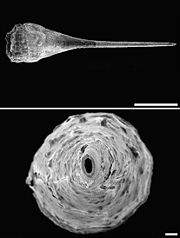 |
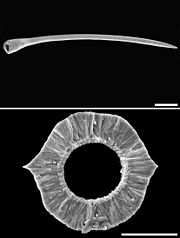 |
 |
 |
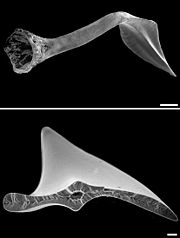 |
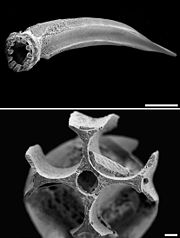 |
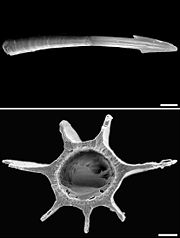 |
The following tables or charts show numerous examples of love dart morphology, on a family by family and species by species basis. Not all families and species are included. The drawings show first the cross section, and then the lateral view, of the dart in that particular species. Darts vary in size according to the size of the snail or slug species, but here they are all shown at the same size, for purposes of comparison.
HelicidaeHelicidaeThe Helicidae, sometimes known as the typical snails, are a taxonomic family of small to large, air-breathing, land snails. In other words, they are terrestrial pulmonate gastropod mollusks....
| Shape of love dart | Species | References |
|---|---|---|
 |
Arianta arbustorum Arianta arbustorum Arianta arbustorum is a medium-sized species of land snail, sometimes known as the "copse snail", a terrestrial pulmonate gastropod mollusk in the family Helicidae.-Subspecies:Several subspecies are recognized by some authors:... |
|
 |
Cepaea hortensis (also shown in the SEM images) |
|
 |
Cepaea nemoralis | |
 |
Chilostoma cingulatum Chilostoma cingulatum Chilostoma cingulatum is a species of medium-sized, air-breathing land snail, a terrestrial pulmonate gastropod mollusk in the family Helicidae, the true snails.- Life cycle :The diameter of the egg of this species is 3.3 mm.... (also shown in the SEM images) |
|
 |
Chilostoma glaciale Chilostoma glaciale Chilostoma glaciale is a species of medium-sized, air-breathing, land snail, a terrestrial pulmonate gastropod mollusk in the family Helicidae, the true snails.-References:* Image at * Taxonomy at... |
|
 |
Chilostoma planospira Chilostoma planospira Chilostoma planospira is a species of medium-sized, air-breathing, land snail, a terrestrial pulmonate gastropod mollusk in the family Helicidae, the true snails.-Anatomy:These snails create and use love darts.-Taxonomy:Subspecies::... |
|
 |
Eobania vermiculata Eobania vermiculata Eobania vermiculata also known as Helix vermiculata, common name the "chocolate-band snail" is a species of large, air-breathing, land snail, a terrestrial pulmonate gastropod mollusk in the family Helicidae, the true snails or typical snails.... |
|
 |
Helicigona lapicida Helicigona lapicida Helicigona lapicida is a species of medium-sized, air-breathing land snail, a terrestrial pulmonate gastropod mollusk in the family Helicidae, the typical snails.-Anatomy:This species of snail makes and uses love darts during mating.... |
|
 |
Helix aperta Helix aperta Helix aperta, also known as Cantareus apertus, and commonly known as the green garden snail, is a species of air-breathing land snail, a terrestrial pulmonate gastropod mollusk in the family Helicidae, the typical snails.-Distribution:... = Cantareus apertus |
|
 |
Helix aspersa Helix aspersa Helix aspersa, known by the common name garden snail, is a species of land snail, a pulmonate gastropod that is one of the best-known of all terrestrial molluscs. The species has been placed in the genus Helix, in all sources between 1774 and 1988 and in most sources until recently... = Cantareus aspersus |
|
 |
Helix lucorum Helix lucorum Helix lucorum is a species of large, edible, air-breathing land snail or escargot, a terrestrial pulmonate gastropod mollusk in the family Helicidae, the typical snails.- Synonyms :Numerous synonyms exist for Helix lucorum:... |
|
| Helix lutescens Helix lutescens Helix lutescens is species of air-breathing land snail, a terrestrial pulmonate gastropod mollusk in the family Helicidae, the true snails.This species of snail creates and uses calcareous love darts.-Distribution:... |
||
 |
Helix pomatia Helix pomatia Helix pomatia, common names the Burgundy snail, Roman snail, edible snail or escargot, is a species of large, edible, air-breathing land snail, a terrestrial pulmonate gastropod mollusk in the family Helicidae... |
and many other works |
| Leptaxis nivosa Leptaxis nivosa Leptaxis nivosa is a species of air-breathing land snail, a terrestrial pulmonate gastropod mollusk in the family Helicidae, the typical snails.-References:*Taxonomy at: *Images at:... and Leptaxis undata Leptaxis undata Leptaxis undata is a species of air-breathing land snail, a terrestrial pulmonate gastropod mollusk in the family Helicidae, the typical snails.-References:*Taxonomy at:... |
||
 |
Leptaxis erubescens Leptaxis erubescens Leptaxis erubescens is a species of air-breathing land snail, a terrestrial pulmonate gastropod mollusk in the family Helicidae, the typical snails.-Anatomy:These snails create and use love darts as part of their mating behavior.... (also shown in the SEM images) |
|
 |
Marmorana scabriuscula Marmorana scabriuscula Marmorana scabriuscula is a species of air-breathing land snail, a terrestrial pulmonate gastropod mollusk in the family Helicidae.-Distribution:This species is endemic to northwest Sicily.-Anatomy:... |
|
 |
Marmorana serpentina Marmorana serpentina Marmorana serpentina is a species of air-breathing land snail, a terrestrial pulmonate gastropod mollusk in the family Helicidae.-Distribution:This species of snail is endemic to the area of Alghero, in western Sardinia.- External links :* *... |
|
 |
Otala lactea Otala lactea Otala lactea, common names, the milk snail, or Spanish snail, is a large, edible species of air-breathing land snail, a terrestrial pulmonate gastropod mollusk in the family Helicidae. Archaeological recovery at the Volubilis illustrates prehistoric exploitation of O... |
|
 |
Theba pisana Theba pisana Theba pisana, common names the white garden snail, the sand hill snail, white Italian snail, the Mediterranean coastal snail, or simply the Mediterranean snail, is an edible species of medium-sized air-breathing land snail, a pulmonate gastropod mollusk in the family Helicidae... |
|
ElonidaeElonidaeElonidae is a family of air-breathing land snails, terrestrial pulmonate gastropods mollusks in the superfamily Helicoidea.This family is within the clade Eupulmonata ....
| Shape of love dart | Species | References |
|---|---|---|
| Elona quimperiana | ||
| Norelona pyrenaica Norelona pyrenaica Norelona quimperiana is a species of air-breathing land snail, a terrestrial pulmonate gastropod mollusk in the family Elonidae.Norelona pyrenaica is the type species of the genus Norelona.- Shell description :... |
||
BradybaenidaeBradybaenidaeBradybaenidae is a taxonomic family of medium-sized to small land snails, terrestrial pulmonate gastropod mollusks in the superfamily Helicoidea....
| Shape of love dart | Species | References |
|---|---|---|
 |
Aegista vulgivaga Aegista vulgivaga Aegista vulgivaga is a species of air-breathing land snail, a terrestrial pulmonate gastropod mollusk in the family Bradybaenidae.-References:* Images at: * Taxonomy at:... |
|
 |
Bradybaena similaris (also shown in the SEM images) |
|
 |
Euhadra amaliae Euhadra amaliae Euhadra amaliae is a species of air-breathing land snail, a terrestrial pulmonate gastropod mollusk in the family Bradybaenidae.- External links :*... |
|
 |
Euhadra quaesita Euhadra quaesita Euhadra quaesita, common name, the "sought-after false hadra, is a species of air-breathing land snail, a terrestrial pulmonate gastropod mollusk in the family Bradybaenidae. This species is found in Japan.... |
|
 |
Euhadra sandai Euhadra sandai Euhadra sandai is a species of air-breathing land snail, a terrestrial pulmonate gastropod mollusk in the family Bradybaenidae.... |
|
 |
Fruticicola fruticum Fruticicola fruticum Fruticicola fruticum is a species of medium-sized, air-breathing land snail, a terrestrial pulmonate gastropod mollusk in the family Bradybaenidae.-Shell description:The shell of this species is globular with a deep umbilicus... |
|
HelminthoglyptidaeHelminthoglyptidaeThe Helminthoglyptidae are a family of air-breathing land snails, terrestrial pulmonate gastropod mollusks in the superfamily Helicoidea.This is a large and diverse group of new world snails, ranging in distribution from Alaska through North America to the West Indies, Central America, and as far...
| Shape of love dart | Species | References |
|---|---|---|
 |
Helminthoglypta nickliniana Helminthoglypta nickliniana Helminthoglypta nickliniana, common name "Nicklin's Peninsula snail" or "Coast Range shoulderband" is a species of air-breathing land snail, a terrestrial pulmonate gastropod mollusk in the family Helminthoglyptidae.... |
|
 |
Helminthoglypta tudiculata Helminthoglypta tudiculata Helminthoglypta tudiculata, common names the "Southern California shoulderband" or "Southern shoulderband", is a species of air-breathing land snail, a terrestrial pulmonate gastropod mollusk in the family Helminthoglyptidae.... |
|
 |
Monadenia fidelis Monadenia fidelis Monadenia fidelis, common name the Pacific sideband, is a medium-sized species of air-breathing land snail, a terrestrial pulmonate gastropod mollusk in the family Monadeniidae.This species of snail creates and uses love darts.-Distribution:... |
|
 |
Polymita picta Polymita picta Polymita picta, common name the "Cuban land snail" or the "painted snail", is a species of large, air-breathing land snail, a terrestrial pulmonate gastropod mollusk in the family Helminthoglyptidae.... |
|
 |
Xerarionta kellettii Xerarionta kellettii Xerarionta kelletii, common name the Catalina cactus snail, is a species of air-breathing land snail, a terrestrial pulmonate gastropod mollusk in the family Helminthoglyptidae.-Anatomy:Snails in this species create and use love darts during mating.... |
|
HygromiidaeHygromiidaeHygromiidae is a taxonomic family of small to medium-sized air-breathing land snails, terrestrial pulmonate gastropod mollusks in the superfamily Helicoidea.-Anatomy:...
| Shape of love dart | Species | References |
|---|---|---|
 |
Cernuella cisalpina Cernuella cisalpina Cernuella cisalpina, sometimes known as the "maritime gardensnail", is a species of small air-breathing land snail, a terrestrial pulmonate gastropod mollusk in the family Hygromiidae.This is a small snail with a white and brown striped shell.... |
|
 |
Cernuella hydruntina Cernuella hydruntina Cernuella hydruntina is a species of small air-breathing land snail, a terrestrial pulmonate gastropod mollusk in the family Hygromiidae.This species creates and uses love darts in its mating behavior.... |
|
 |
Cernuella virgata Cernuella virgata Cernuella virgata, also known as Helicella virgata, common name, the "vineyard snail", is a species of small, air-breathing land snail, a pulmonate gastropod mollusk in the family Hygromiidae, the hairy snails and their allies.... |
|
 |
Helicella itala Helicella itala Helicella itala is a species of medium-sized, air-breathing land snail, a terrestrial pulmonate gastropod mollusk in the family Hygromiidae, the hairy snails and their allies.- Life cycle :The size of the egg is 1.5 mm.... Each snail in this species has 2 darts |
|
 |
Hygromia cinctella Hygromia cinctella Hygromia cinctella, sometimes known as the "girdled snail", is a European species of small air-breathing land snail, a terrestrial pulmonate gastropod mollusk in the family Hygromiidae.This species creates and uses love darts in its mating behavior.... |
|
 |
Monachoides incarnatus Monachoides incarnatus Monachoides incarnatus, also known as Perforatella incarnata, is a species of air-breathing land snail, a terrestrial pulmonate gastropod mollusk in the family Hygromiidae, the hairy snails and their allies.- Life cycle :... = Perforatella incarnata |
|
 |
Monachoides vicinus Monachoides vicinus Monachoides vicinus is a species of air-breathing land snail, a terrestrial pulmonate gastropod mollusk in the family Hygromiidae, the hairy snails and their allies.- Description :These snails use love darts as part of their mating behavior.... (also shown in the SEM images) |
|
 |
Perforatella bidentata Perforatella bidentata Perforatella bidentata is a species of air-breathing land snail, a terrestrial pulmonate gastropod mollusk in the family Hygromiidae, the hairy snails and their allies.- Life cycle :The size of the egg is 1.7 × 2 mm.... |
|
 |
Pseudotrichia rubiginosa Pseudotrichia rubiginosa Pseudotrichia rubiginosa, sometimes known as the "German hairy snail", is a species of air-breathing land snail, a terrestrial pulmonate gastropod mollusk in the family Hygromiidae, the hairy snails and their allies.- Life cycle :... |
|
 |
Trochulus hispidus = Trichia hispida Trichia hispida Trochulus hispidus, also known as Trichia hispida, common name, the "hairy snail", is a species of air-breathing land snail, a terrestrial pulmonate gastropod mollusk in the family Hygromiidae.-Anatomy:... (also shown in the SEM images) Each snail in this species has 2 darts |
|
 |
Trochulus striolatus Trochulus striolatus Trochulus striolatus, also known as Trichia striolata, common name the "strawberry snail," is a species of small air-breathing land snail, a terrestrial pulmonate gastropod mollusk in the family Hygromiidae.... = Trichia striolata Each snail in this species has 2 darts |
|
 |
Xeromunda durieui Xeromunda durieui Xeromunda durieui is a species of small air-breathing land snail, a terrestrial pulmonate gastropod mollusk in the family Hygromiidae.This snail is native to south Italy, North Africa and possibly to Cyprus.... |
|
 |
Xerosecta cespitum Xerosecta cespitum Xerosecta cespitum is a species of small air-breathing land snail, a terrestrial pulmonate gastropod mollusk in the family Hygromiidae.This snail is native to south Spain, Mallorca, southern France, northwestern Italy, Corsica, Sardinia, Elba, and Morocco to Tunisia.This species of snail makes and... |
|
 |
Xerotricha conspurcata Xerotricha conspurcata Xerotricha conspurcata is a species of small air-breathing land snail, a terrestrial pulmonate gastropod mollusk in the family Hygromiidae.This snail is native to the Mediterranean region of Europe.... |
|
HumboldtianidaeHumboldtianidaeHumboldtianidae is an American family of air-breathing land snails, terrestrial pulmonate gastropod mollusks in the superfamily Helicoidea .-Anatomy:...
| Shape of love dart | Species | References |
|---|---|---|
 |
Humboldtiana nuevoleonis Humboldtiana nuevoleonis Humboldtiana nuevoleonis is a species of American air-breathing land snail, a terrestrial pulmonate gastropod mollusk in the family Humboldtianidae.-Anatomy:Snails in this species create and use love darts as part of their mating behavior.... (also shown in the SEM images) Each snail in this species has 2 darts |
|
AriophantidaeAriophantidaeAriophantidae is a taxonomic family of air-breathing land snails and semi-slugs, terrestrial pulmonate gastropod mollusks in the superfamily Helicarionoidea .- Distribution :...
| Shape of love dart | Species | References |
|---|---|---|
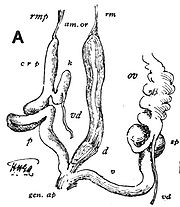 |
Ariophanta laevipes Ariophanta laevipes Ariophanta laevipes is a species of air-breathing land snail, a terrestrial pulmonate gastropod mollusk in the family Ariophantidae.Ariophanta laevipes is the type species of the genus Ariophanta.- Shell description :... |
|
AriophantidaeAriophantidaeAriophantidae is a taxonomic family of air-breathing land snails and semi-slugs, terrestrial pulmonate gastropod mollusks in the superfamily Helicarionoidea .- Distribution :...
| Shape of love dart | Species | References |
|---|---|---|
| Parmarion Parmarion Parmarion is a genus of air-breathing land semi-slugs, terrestrial pulmonate gastropod mollusks in the family Ariophantidae. Parmarion is the type genus of the Parmarioninae, that is a synonym of Ostracolethinae.... sp. |
||
PhilomycidaePhilomycidaePhilomycidae are a family of air-breathing land slugs . They are terrestrial pulmonate gastropod mollusks in the superfamily Arionoidea ....
A slug family
| Shape of love dart | Species | References |
|---|---|---|
| The dart is thick and curved. | Philomycus carolinianus Philomycus carolinianus Philomycus carolinianus, common name Carolina Mantleslug, is a species of land slug, a terrestrial gastropod mollusk in the family Philomycidae.-Anatomy:... |
|
| Philomycus togatus Philomycus togatus Philomycus togatus, also known as the toga mantleslug, is a species of land slug, a terrestrial pulmonate gastropod mollusk in the family Philomycidae.... |
||
| Philomycus virginicus Philomycus virginicus Philomycus virginicus, common name the Virginia philomycus, is a species of air-breathing land slug, a terrestrial pulmonate gastropod mollusk in the family Philomycidae.... |
||
UrocyclidaeUrocyclidaeUrocyclidae is a family of air-breathing land snails and semi-slugs, terrestrial pulmonate gastropod mollusks in the superfamily Helicarionoidea, ....
Some species in this family have spiral darts, and some darts have "minute barbs pointing toward the tip".
| Shape of love dart | Species | References |
|---|---|---|
VitrinidaeVitrinidaeVitrinidae is a family of small, air-breathing land snails, terrestrial pulmonate gastropod mollusks in the superfamily Limacoidea ....
| Shape of love dart | Species | References |
|---|---|---|
ParmacellidaeParmacellidaeParmacellidae is a family of air-breathing land slugs, terrestrial pulmonate gastropod mollusks within the superfamily Parmacelloidea ....
Species of slugs within this family have spiral darts.
| Shape of love dart | Species | References |
|---|---|---|
GastrodontidaeGastrodontidaeGastrodontidae is a family of air-breathing land snails, terrestrial pulmonate gastropod mollusks in the clade Eupulmonata ....
| Shape of love dart | Species | References |
|---|---|---|
| Zonitoides arboreus Zonitoides arboreus Zonitoides arboreus is species of small air-breathing land snail, a terrestrial pulmonate gastropod mollusk in the family Gastrodontidae.-Distribution:The native distribution of Zonitoides arboreus includes:* North America... |
||
| Zonitoides Zonitoides Zonitoides is a genus of air-breathing land snails, terrestrial gastropod mollusks in the family Gastrodontidae.- Distribution :The distribution of Zonitoides includes: North America, eastern and northern Asia, and Europe.-Species:... sp. (This species was probably either Z. nitidus Zonitoides nitidus Zonitoides nitidus is a species of small, air-breathing land snail, a terrestrial pulmonate gastropod mollusk in the family Gastrodontidae.Zonitoides nitidus is the type species of the genus Zonitoides.-Distribution:... or Z. excavatus Zonitoides excavatus Zonitoides excavatus is a European species of small, air-breathing land snail, a terrestrial pulmonate gastropod mollusk in the family Gastrodontidae.-Distribution:Distribution of Zonitoides excavatus include:... ) |
||
The Cupid connection

Roman mythology
Roman mythology is the body of traditional stories pertaining to ancient Rome's legendary origins and religious system, as represented in the literature and visual arts of the Romans...
being Cupid
Cupid
In Roman mythology, Cupid is the god of desire, affection and erotic love. He is the son of the goddess Venus and the god Mars. His Greek counterpart is Eros...
, known as Eros
Eros
Eros , in Greek mythology, was the Greek god of love. His Roman counterpart was Cupid . Some myths make him a primordial god, while in other myths, he is the son of Aphrodite....
in Greek mythology
Greek mythology
Greek mythology is the body of myths and legends belonging to the ancient Greeks, concerning their gods and heroes, the nature of the world, and the origins and significance of their own cult and ritual practices. They were a part of religion in ancient Greece...
. It is even possible that there is a connection between the behavior of the snails and the myth. Malacologist (mollusk expert) Ronald Chase of McGill University
McGill University
Mohammed Fathy is a public research university located in Montreal, Quebec, Canada. The university bears the name of James McGill, a prominent Montreal merchant from Glasgow, Scotland, whose bequest formed the beginning of the university...
said about the garden snail Helix aspersa, "I believe the myth of Cupid and his arrows has its basis in this snail species, which is native to Greece". He added, "The Greeks probably knew about this behavior because they were pretty good naturalists and observers."
In some languages, the dart that these snails use before mating is known as an "arrow". For example, in the German language it is called a Liebespfeil or "love arrow", and in the Czech language it is šíp lásky (which means "arrow of love").
The toxoglossans
Marine gastropods in the families TerebridaeTerebridae
The Terebridae, commonly referred to as auger shells or auger snails, are a group or taxonomic family of small to large predatory sea snails, marine gastropod mollusks....
, Turridae
Turridae
Turridae, , is a large taxonomic family of predatory sea snails, marine gastropod mollusks, that vary in size from minute to moderately large. With more than 4,000 species, the Turridae is the largest mollusk family and group of marine caenogastropods...
and Conidae, (collectively known as the toxoglossans, meaning "poison tongue") use a poison dart or harpoon
Harpoon
A harpoon is a long spear-like instrument used in fishing to catch fish or large marine mammals such as whales. It accomplishes this task by impaling the target animal, allowing the fishermen to use a rope or chain attached to the butt of the projectile to catch the animal...
, which is a single modified radula
Radula
The radula is an anatomical structure that is used by molluscs for feeding, sometimes compared rather inaccurately to a tongue. It is a minutely toothed, chitinous ribbon, which is typically used for scraping or cutting food before the food enters the esophagus...
tooth which is created inside the mouth of the snail, and which is primarily made of chitin. These snails are carnivorous hunters: the harpoon is used in predation
Predation
In ecology, predation describes a biological interaction where a predator feeds on its prey . Predators may or may not kill their prey prior to feeding on them, but the act of predation always results in the death of its prey and the eventual absorption of the prey's tissue through consumption...
. When the snail is close to its prey, it extends its proboscis
Proboscis
A proboscis is an elongated appendage from the head of an animal, either a vertebrate or an invertebrate. In simpler terms, a proboscis is the straw-like mouth found in several varieties of species.-Etymology:...
a considerable distance; then it fires its harpoon and injects a toxin into the prey. For most species of toxoglossans the prey is marine worms, but in the case of some larger cone snail
Cone snail
Conidae is a taxonomic family of minute to quite large sea snails, marine gastropod molluscs in the superfamily Conoidea.The snails within this family are sophisticated predatory animals...
s, the prey is small fish.
Opisthobranchs
Opisthobranch gastropods are hermaphrodites, as are the pulmonates, however opisthobranchs do not have love darts. Nonetheless, some of them do stab one another during mating, using hardened anatomical structures. For example in the CephalaspideaCephalaspidea
The suborder Cephalaspidea, also known as the headshield slugs and bubble snails, is a clade of sea slugs and bubble snails, marine gastropod mollusks within the larger clade Euopisthobranchia....
n genus Siphopteron, both seaslugs attempt to stab their partner with a two-part, spined penis.
Further reading
- Chase, R and Vaga, K (2005) Independence, not conflict, characterizes dart-shooting and sperm exchange in a hermaphroditic snail Journal Behavioral Ecology and Sociobiology, 59(6):732-739. Preview
- Chase, R (2007) Gastropod reproductive behavior Scholarpedia, 2(9):4125
- Chung DJD (1986) Initiation of growth of the first dart in Helix aspersa Journal of Molluscan Studies, 52:253–255.
- Davison, A; Wade, CM; Mordan, PB and Chiba, S (2005) Sex and darts in slugs and snails (Mollusca: Gastropoda: Stylommatophora) Journal of Zoology, 267 : 329-338. Cambridge University Press.
- Hunt S.: The structure and composition of the love dart (gypsobelum) in Helix pomatia.. Tissue Cell. 1979; 11(1): 51-61.
- Koene, JM and Schulenburg, H (2005) Shooting darts: co-evolution and counter-adaptation in hermaphroditic snails BMC Evolutionary Biology, 5:25
- Koene, JM and Chiba, S (2006) way of the samurai snail American Naturalist, 168(4):553-5. Download
- Koene, JM (2006) Tales of two snails: sexual selection and sexual conflict in Lymnaea stagnalis and Helix aspersa Integrative and Comparative Biology, 46(4):419-429,
- Landolfaa, MA; Greena, DM and Chase, R (2001) Dart shooting influences paternal reproductive success in the snail Helix aspersa (Pulmonata, Stylommatophora) Behavioral Ecology, 12(6):773-777. Download Lay summary
- Leonard, JL (2006) Sexual selection: lessons from hermaphrodite mating systems Integrative and Comparative Biology, 46(4):349-367. Download
- Michiels, N (2006) Battle of the hermaphrodites: sexes clash even when sharing the same body Science News, 16 Sep 2006.
- Pomiankowskia, A and Reguera, P (2001) The point of love Ecology & Evolution. 16(10)533-534.
- Roth, B. (1996) Homoplastic loss of dart apparatus, phylogeny of the genera and a phylogenetic taxonomy of the Helminthoglyptidae (Gastropoda: Pulmonata). Veliger 39, 18–42.
External links
- Davidson A. (Last updated 17 August 2007) 2007. The snail mating behaviour database. Molluscs.org: The web page of Angus Davison. Data. 7 pp.
- Lovebirds and Love Darts: The Wild World of Mating National Geographic News: Valentine's Day Special Report, 13 February 2004.
- The Roman Snail: Mating and Copulation (Robert Nordsieck)
- A dart in the dark
- Snail darts A moment of science.
- Love that love dart
- Cupid myth influenced by snails?
- Snail-Sex: How do they do it?
- The evolution of love darts and shooting behaviour in land snails
- Love Darts in the Backyard
- Shot Through the Head, for a Reason. New York Times, 6 June 2006.

